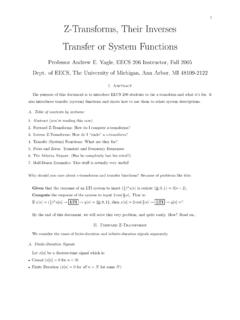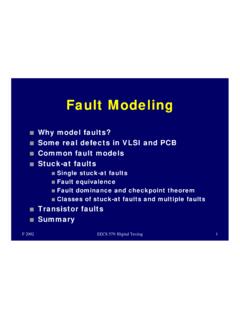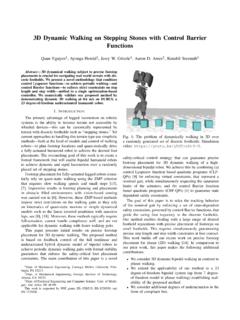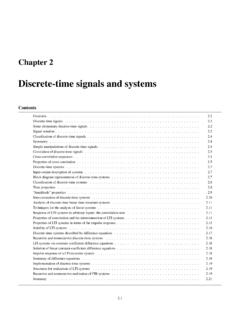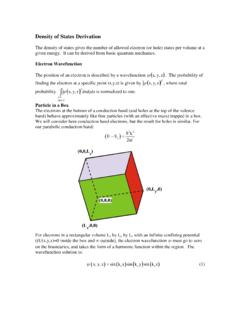Transcription of C Review and Special Topics for Embedded Programming
1 1 Special Topics forEmbedded Programming1 Reference: The C Programming Language by Kernighan & Ritchie2 Overview of Topics Microprocessor architecture Peripherals Registers Memory mapped I/O C Programming for Embedded systems2 C Programming for Embedded systems Lab 1: General Purpose I/O Read data from input pins and write to output pins on the MPC5553 GPIO example code3 Freescale MPC55xx Architecture 132 MHz 32-bit PowerPC, Temperature range: -40 to 125 C MB of Embedded Flash 64 KB on-chip static RAM 8 KB of cache 210 selectable-priority interrupt sourcessources 3 DSPI (serial peripheral interface) 2 eSCI (serial communications) GPIO 2 x 40-ch. ADC 24-ch. eMIOS 2 CAN 32-ch. eTPU Direct Memory Access (DMA)4 Microprocessor Architecture Microprocessor memory has location ( address ) and contents (the data stored at a specific address in memory) Data are accessed by specifying a location on the address bus, and reading the contents of the specified address on the data specified address on the data bus Registers are memory locations used for calculations, to initialize the processor or check its status, or to access peripheral devices.
2 General purpose registers Special purpose registers5 General Purpose Registers Hold data values before and after calculations C compilers automatically use these registers as resources to +GPR 3: 5 GPR 4: 2 GPR 2: 75registers as resources to load/store data & perform calculations6 Special Purpose Registers: Memory Mapped I/O Access peripherals by writing to and reading from memory Each peripheral has a fixed range of memory addresses assigned to it6 These are memory-mapped registers, used for interacting with peripherals Memory locations can be: Peripheral configuration registers Peripheral status registers inputs from the hardware outputs to the hardware7C Programming for Embedded Systems7 Systems8 Primitive Data Types, Data Declaration Integer data types Have both size and sign char (8-bit) short (16-bit) int (32-bit) long (32-bit) signed (positive and negative) unsigned (positive only){/* Top of Code Block */signed char A;char input;unsigned short var;int output;8 unsigned (positive only) Floating-point types Only have size Can always be positive or negative float (32-bit) double (64-bit) Data declarations should be at the top of a code blockint output;unsigned long var2;float realNum;double realNum2.}
3 }9 Freescale Defined Types See typedef signed char int8_t; typedef unsigned char uint8_t; typedef volatile signed char vint8_t; typedef volatile signed char vint8_t; typedef volatile unsigned char vuint8_t; typedef signed short int16_t; typedef unsigned short uint16_t; ..10 Function Prototype declares name, parameters and return type prior to the functions actual declaration Information for the compiler; does not include the actual function code You will be given function prototypes to access peripherals Pro forma: RetType FcnName (ArgType ArgName, .. );Functions and Function Prototypesint Sum (int a, int b); /* Function Prototype */void main()void main(){c = Sum ( 2, 5 ); /* Function call */}int Sum (int a, int b) /* Function Definition */{ return ( a + b );}11C vs. C++ C++ language features cannot be used No new, delete, class Comment with /* */, not // Variables must be declared at top of code blocks{11int j;double x;/* code */int q; /* only in C++, not in C *//* code */}12 Useful Features for Embedded Code Type Qualifiers Volatile Static Pointers12 Structures Unions Bit Operations Integer Conversions13 Volatile Type Qualifier Variables that tend to be reused repeatedly in different parts of the code are often identified by compilers for optimization.
4 These variables are often stored in an internal register that is read from or written to whenever the variable is accessed in the code. This optimizes performance and can be a useful feature Problem for Embedded code: Some memory values may change without software action! Example: Consider a memory-mapped register representing a DIP-switch input13 Example: Consider a memory-mapped register representing a DIP-switch input Register is read and saved into a general-purpose register Program will keep reading the same value, even if hardware has changed Use volatilequalifier: Value is loaded from or stored to memory every time it is referenced Example: volatile unsigned char *GPIO_pointer;14 Static Type Qualifier Variables local to functions are destroyed when the function returns a value and exits (they have local scope) In Embedded code we often want a variable to retain its value between function calls Consider a function that senses a change in the crankshaft angle: The function needs to know the previous angle in order to compute the difference14previous angle in order to compute the difference If a local variable within a function is declared static, it is stored in the heap (a dedicated pool of memory) instead of the function stack (a temporary storage) and will thus retain its value between subsequent function calls When used with global variables and functions, static limits the scope of the variable to its file.
5 Example: static int x = 2 ;15 Pointers Every variable has an addressin memory and a value A pointer is a variable that stores an address The value of a pointer is the location of another variable The size of a pointer variable is the size of an address15 The size of a pointer variable is the size of an address 4 bytes (32 bits) for the MPC5553 Two operators used with pointers &operator returns the address of a variable *is used to de-reference a pointer ( , to access the valueat the addressstored by a pointer16 Pointer ExampleAddress Value Variable0x1005x0x1045y0x1080x100ptr16int x, y;/* x is located at address 0x100 */int *ptr;/* This is how to declare a pointer */x = 5;ptr = &x; /* The value of ptr is now 0x100 */y = *ptr;/* y now has the value 5 */*ptr =6;/* The value at address 0x100 is 6 */0x1080x100ptr17 More Pointer Examples Declare a pointer,volatile int *p; Assign the address of the I/O memory location to the pointer,p = (volatile int*) 0x30610000; /* 4-byte long, address of some memory-mapped register */17mapped register */ Output a 32-bit value by setting the value of bytes at 0x30610000,*p = 0x7 FFFFFFF; /* Turn on all but the highest bit */ Alternatively,*((volatile unsigned short*)(0x30610000)) = 0x7 FFF;18 Structures A structholds multiple variables Divides range of memory into pieces that can be referenced individually The following structure creates a variablexof type rationalwith members nand dstruct rational { short n; short d; } x; d; } x; = 2; = 5; Recall: We can treat a peripheral s memory map as a range of memory.)
6 Result: We can use a structure and its member variables to access peripheral Access structure member variables using . and -> .is used with structures ->is used with pointers-to-structures/* Definition */struct student{char firstnm[32];char lastnm[32];int age;};void main() Example bobis a variable of type student Assign firstnm, lastnmand age Increment agevoid main(){struct student bob;struct student *pbob; = 20;strcpy( , Bob );strcpy( , Smith );pbob = pbob->age++; /* same as (*pbob).age++ */};20 Structure bit-fieldsNumber of bits per data member in structures is specified with :n struct RGB_color{unsigned char r:2; /* 2-bits */unsigned char g:2;unsigned char b:2;/* padding */unsigned char:2; /*don t need to explicitly do this. */};rgb(padding)8 bits/* reset g */struct RGB_color clr; = 0 ;21 Bit-Fields Diagram But what if we want to access r,g & b all at the same time?0x00000x01000x0200the same time?..r g b space22 Unions Multiple ways to view memory locations Unions contain member variables Member variables share same memory All variables are overlaid on each other Changing one member results in the other 22members being changed Union is as long as longest memberTwo waysTo read theSame memorylocationrgb: 6r : 2 g : 2b : 2paddingpaddingMemory Location 0x071623 Unionsunion RGB_color{struct {unsigned char r:2,g:2,b:2;unsigned char:2;};rgbspacergbclr:};struct {unsigned char rgb:6;unsigned char:2;}};union RGB_color clr.
7 0x00 0x02 0x040x0624 Pros & Cons of Using Structures Pros Readable code Simple way to set or clear individual bits Cons24 Cons Relies on the compiler implementation Assembly code for a simple bit-write is much longer than if registers were directly written to25 Constants and Bit Operations25 Tools for Manipulating Values26 Integer Constants Binary constant: 0bnumber Example: 0b10110000 Octal constant: 0number(prefix is a zero) Example: 0775 Hexadecimal constant: 0xnumber26 Hexadecimal constant: 0xnumber Example: 0xffff or 0xFFFF27 Bit Operations Bit-shiftsRight shift:num >> shift 0b1001 >> 2 0b0010 Left shift: num << shift 0b0011 << 2 0b1100 MaskingBit-or:num | mask 0b0001 | 0b1000 0b1001 Bit-and:num & mask 0b1001 & 0b1000 0b100027 ComplementNot:~ num ~ 0b0101 0b1010 Set bitsset the 5th bitx = x | (1 << 4);set the 5th bitx |= (1 << 4); Clear bitsclear 5th and 6th bitx = x & ~(0b11 << 4);clear 5th and 6th bitx &= ~(0b11 << 4);28 Type Conversions Explicit Casts For specifying the new data type Syntax:(type-name)expression Example:(int)largeVar Integral Promotion Before basic operation ( + - * /), both operands converted to same type The smaller type is promoted (increased in size) to the larger 28 The smaller type is promoted (increased in size) to the larger type Value of promoted type is preserved Implicit Casts Assigning a value into a different type Widening conversion preserve value of expressionshort x = 10; long y = x; Narrowing conversions do NOT preserve valueunsigned long x = 257;unsigned char y = x.
8 29 Integer Division When dividing two numbers, may receive unexpected results If both operands are integers, then result is integer Expected result of division is truncated to fit into an integer If one operand is floating-point, then result is floating-point Integer operand is promoted to floating-point Receive expected result/* floating-point results */29/* floating-point results */( / ) /* no promotion, result is float */( / 2) /* operand 2 promoted to float */(5 / ) /* operand 5 promoted to float *//* integer-valued results */(5 / 2) 2 /* no promotion, result is integer */30 Lab 1 Familiarization and Digital I/OEECS461 F07 - Special Topics for Embedded Programming30 Familiarization and Digital I/O31 Lab 1 Program the MPC5553 for Digital I/O. Write C code that performs low-level bit manipulation and writes to memory mapped registers Write a simple program ( ) to add two 4-bit numbers specified on the DIP switches on the interface board and echo the results onto the LED display31echo the results onto the LED display Modify your program to use serial interface and keyboard instead of DIP switches MPC5553/MPC5554 Microcontroller Reference Manual (on website verylarge: do not print!)
9 Chapter 6, Section System Integration Unit (SIU) Chapter 6, Section , Memory Map/Register Definition32 Lab 1 GPIO32 Interface board connects to pads 122 through 137 for input from DIP switches, and 28 through 43for output to 1 GPIO Three registers for each pin Pad Configuration register (PCR) General Purpose Data Input register (GPDI)register (GPDI) General Purpose Data Output register (GPDO) Many other SIU registers Most pins have alternate function (connected to other peripherals) See SIU memory map, Table Map Table Registers For each pin: Pad Configuration Register (PCR) ( ) Set pin purpose Turn on/off voltage buffers Data Input Register (GPDI) 34 Data Input Register (GPDI) ( ) Read voltage on pin On is 1, off is 0 Data Output Register (GPDO) ( ) Set voltage on pin On is 1, off is 035 SIU Pad Configuration Register Section , Table 6-15. SIU_PCR Field Descriptions PA: Pin assignment (selects the function of a multiplexed pad) OBE: Output buffer enable35 IBE: Input buffer enable DSC: Drive strength control ODE: Open drain output enable HYS: Input hysteresis enable SRC: Slew rate control WPE: Weak pull up/down enable (Disablepull up) WPS: Weak pull up/down select36 SIU Pad Configuration Registertypedef union siu_pcr_u {/* Pad Configuration Registers */volatile unsigned short REG;struct {volatile unsigned short :3;volatile unsigned short PA:3;volatile unsigned short OBE:1;volatile unsigned short IBE:1; Union accesses entire register or individual bit fields Provide one union generic enough to suit any SIU pad There are over 200 configuration registers!}}
10 36volatile unsigned short IBE:1;volatile unsigned short DSC:2;volatile unsigned short ODE:1;volatile unsigned short HYS:1;volatile unsigned short SRC:2;volatile unsigned short WPE:1;volatile unsigned short WPS:1;} FIELDS;} SIU_PCR;configuration registers! Address each configuration register by declaring your union as a pointer Use pointer indexing ( : padptr[122]) to access a specific register37 MPC5553 Register Definitions/**//* FILE NAME: COPYRIGHT (c) Freescale 2005 *//* VERSION: All Rights Reserved *//* *//* DESCRIPTION: */ has registers, bit field definitions Don t have to write your own structure (except 37/* This file contains all of the register and bit field definitions for *//* MPC5553. *//*==================================== *//*>>>>NOTE!)

